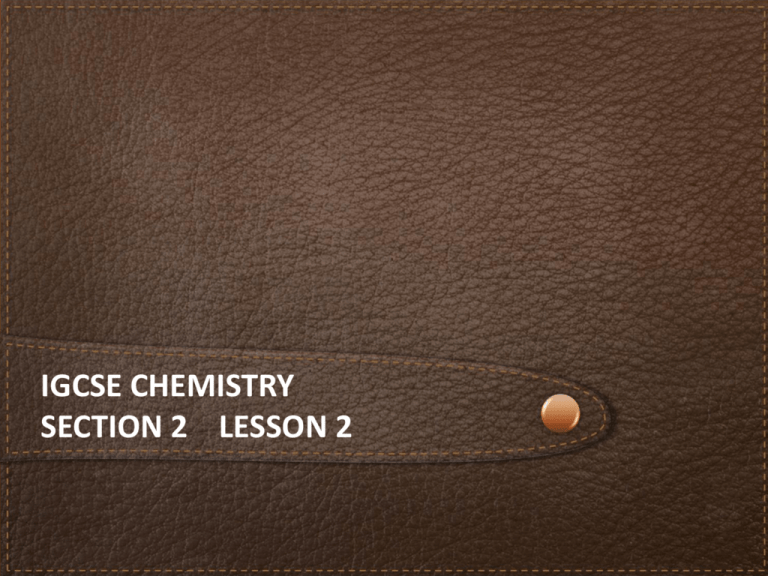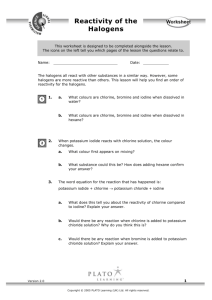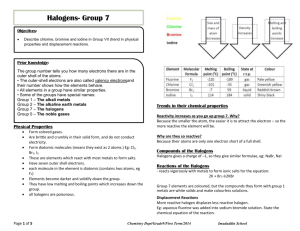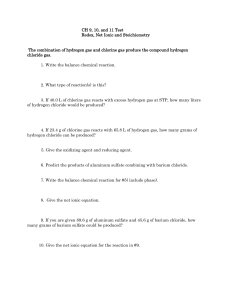Section 2 - iGCSE Science Courses
advertisement

IGCSE CHEMISTRY SECTION 2 LESSON 2 Content The iGCSE Chemistry course Section 1 Principles of Chemistry Section 2 Chemistry of the Elements Section 3 Organic Chemistry Section 4 Physical Chemistry Section 5 Chemistry in Society Content Section 2 Chemistry of the Elements a) b) c) d) e) f) g) The Periodic Table Group 1 Elements Group 7 Elements Oxygen and Oxides Hydrogen and Water Reactivity Series Tests for ions and gases Content Lesson 2 c) Group 7 elements d) Oxygen and oxides c) Group 7 elements — chlorine, bromine and iodine 2.9 recall the colours and physical states of the elements at room temperature 2.10 make predictions about the properties of other halogens in this group 2.11 understand the difference between hydrogen chloride gas and hydrochloric acid 2.12 explain, in terms of dissociation, why hydrogen chloride is acidic in water but not in methylbenzene 2.13 describe the relative reactivities of the elements in Group 7 2.14 describe experiments to demonstrate that a more reactive halogen will displace a less reactive halogen from a solution of one of its salts 2.15 understand these displacement reactions as redox reactions. d) Oxygen and oxides 2.16 recall the gases present in air and their approximate percentage by volume 2.17 explain how experiments involving the reactions of elements such as copper, iron and phosphorus with air can be used to investigate the percentage by volume of oxygen in air 2.18 describe the laboratory preparation of oxygen from hydrogen peroxide,using manganese(IV) oxide as a catalyst 2.19 describe the reactions of magnesium, carbon and sulfur with oxygen in air, and the acid-base character of the oxides produced 2.20 describe the laboratory preparation of carbon dioxide from calcium carbonate and dilute hydrochloric acid 2.21 describe the formation of carbon dioxide from the thermal decomposition of metal carbonates such as copper(II) carbonate 2.22 describe the properties of carbon dioxide, limited to its solubility and density 2.23 explain the use of carbon dioxide in carbonating drinks and in fire extinguishers, in terms of its solubility and density 2.24 understand that carbon dioxide is a greenhouse gas and may contribute to climate change. Group 7 elements – chlorine, bromine and iodine The HALOGENS Group 7 elements – chlorine, bromine and iodine The HALOGENS All have seven electrons in their outer shell. To become stable they gain an electron and carry a charge of -1. eg. Br- I- Cl- Group 7 elements – chlorine, bromine and iodine The HALOGENS Five non-metals Group 7 elements – chlorine, bromine and iodine The HALOGENS Five non-metals Low melting and boiling points, increasing going down the group Group 7 elements – chlorine, bromine and iodine Gas Gas Liquid Solid Solid All have coloured vapours. Chlorine and bromine are extremely pungent (causing a sharp or irritating sensation) Group 7 elements – chlorine, bromine and iodine The HALOGENS are diatomic – this means that they go around as paired atoms. Group 7 elements – chlorine, bromine and iodine The HALOGENS are diatomic – this means that they go around as paired atoms. Cl2 Br2 Group 7 elements – chlorine, bromine and iodine The HALOGENS are diatomic – this means that they go around as paired atoms. Brittle and crumbly when solid. Cl2 Br2 Group 7 elements – chlorine, bromine and iodine Poor conductors of heat and electricity, even when solid or liquid. Group 7 elements – chlorine, bromine and iodine Going down the group, the halogens become less reactive. Poor conductors of heat and electricity, even when solid or liquid. Group 7 elements – chlorine, bromine and iodine Halogens react with other non-metallic elements, such as hydrogen, to form molecular compounds: Eg. hydrogen + chlorine hydrogen chloride H2(g) + Cl2(g) 2HCl(g) What’s the difference between hydrogen chloride and hydrochloric acid (they both have the same chemical formula – HCl) What’s the difference between hydrogen chloride and hydrochloric acid (they both have the same chemical formula – HCl) Hydrogen chloride is gaseous at room temperature. Hydrochloric acid is an aqueous solution of hydrogen chloride – i.e. dissolved in water. Explain, in terms of dissociation, why hydrogen chloride is acidic in water but not in methylbenzene Explain, in terms of dissociation, why hydrogen chloride is acidic in water but not in methylbenzene ? Explain, in terms of dissociation, why hydrogen chloride is acidic in water but not in methylbenzene ? “To separate, or split, into smaller particles or ions” Hydrogen chloride? Hydrogen chloride? Hydrogen chloride is a covalent compound. However, when dissolved in water it dissociates to the separate ions, H+ and CL-. The H+ ion gives it acidic properties. Hydrogen chloride? When dissolved in an organic solvent, such as methylbenzene, hydrogen chloride does not dissociate into separate ions, so does not show acidic properties. Hydrogen chloride? When dissolved in an organic solvent, such as methylbenzene, hydrogen chloride does not dissociate into separate ions, so does not show acidic properties. Reactions of the halogens Halogens react with metals to produce ionic salts The halogen atom gains one electron to form the halide ion which carries a charge of -1 eg. Lithium + chlorine lithium chloride 2Li(s) + Cl2(g) 2LiCl(s) Reactions of the halogens Halogens react with metals to produce ionic salts The halogen atom gains one electron to form the halide ion which carries a charge of -1 eg. Lithium + chlorine lithium chloride 2Li(s) + Cl2(g) 2LiCl(s) YouTube video: comparing the four halogens Reactions of the halogens Summary: Halogens + Hydrogen hydrogen halides HF, HCl, HBr, HI All four are gases and very soluble in water Halogens + Aluminium Aluminium trihalides AlF3, AlCl3, AlBr3, AlI3 All four are white solids Describe experiments to demonstrate that a more reactive halogen will displace a less reactive halogen from a solution of one of its salts Describe experiments to demonstrate that a more reactive halogen will displace a less reactive halogen from a solution of one of its salts ? Describe experiments to demonstrate that a more reactive halogen will displace a less reactive halogen from a solution of one of its salts ? “In a displacement reaction a more reactive element will displace a less reactive element from a compound.” Halogen displacement reactions Remember that the reactivity of the halogens decreases as we go down the group, so Fluorine is the most reactive halogen, and Astatine is the least reactive – can you explain this trend in terms of the number of electron shells? (hint – think back to the Alkali metals) Halogen displacement reactions A more reactive halogen will displace a less reactive halogen from an aqueous solution of its salt. e.g. potassium iodide + chlorine potassium chloride + iodine 2KI + Cl2 2KCl + I2 Halogen displacement reactions A more reactive halogen will displace a less reactive halogen from an aqueous solution of its salt. e.g. potassium iodide + chlorine potassium chloride + iodine 2KI + Cl2 KI solution Displaced iodine Cl2 2KCl + I2 Halogen displacement reactions A more reactive halogen will displace a less reactive halogen from an aqueous solution of its salt. e.g. potassium iodide + chlorine potassium chloride + iodine 2KI + Cl2 Displaced iodine + I2 Potassium chloride KCl Potassium bromide KBr Potassium Iodide KI Chlorine Cl2 X Bromine + KCl Iodine + KCl Bromine Br2 No reaction X Iodine + KBr Iodine I2 No reaction No reaction X Cl2 KI solution 2KCl Understand these displacement reactions as redox reactions Understand these displacement reactions as redox reactions ? Understand these displacement reactions as redox reactions ? “A redox reaction is where both oxidation and reduction occur.” Redox reaction? Hydrogen chloride? The loss of electrons from an atom is known as oxidation. The gain of electrons is known as reduction. Hydrogen chloride? Remember OILRIG Oxidation Is Loss = OIL Reduction Is Gain = RIG Hydrogen chloride? Remember OILRIG Oxidation Is Loss = OIL Reduction Is Gain = RIG Halogen displacement reactions e.g. potassium iodide + chlorine potassium chloride + iodine 2KI 2K+ 2I- + Cl2 2KCl 2K+ 2Cl- + I2 Halogen displacement reactions e.g. potassium iodide + chlorine potassium chloride + iodine 2KI 2K+ 2I- + Cl2 2KCl 2K+ 2Cl- iodine loses 2e- (2I- I2) + I2 Halogen displacement reactions e.g. potassium iodide + chlorine potassium chloride + iodine 2KI 2K+ 2I- + Cl2 2KCl 2K+ 2Cl- iodine loses 2e- (2I- I2) + I2 Halogen displacement reactions e.g. potassium iodide + chlorine potassium chloride + iodine 2KI 2K+ 2I- + Cl2 2KCl 2K+ 2Cl- iodine loses 2e- (2I- I2) iodine has been oxidised + I2 Halogen displacement reactions e.g. potassium iodide + chlorine potassium chloride + iodine 2KI 2K+ 2I- + Cl2 2KCl 2K+ 2Cl- chlorine gains 2e- (Cl2 2Cl-) + I2 Halogen displacement reactions e.g. potassium iodide + chlorine potassium chloride + iodine 2KI 2K+ 2I- + Cl2 2KCl 2K+ 2Cl- chlorine gains 2e- (Cl2 2Cl-) + I2 Halogen displacement reactions e.g. potassium iodide + chlorine potassium chloride + iodine 2KI 2K+ 2I- + Cl2 2KCl 2K+ 2Cl- chlorine gains 2e- (Cl2 2Cl-) chlorine has been reduced + I2 Halogen displacement reactions e.g. potassium iodide + chlorine potassium chloride + iodine 2KI 2K+ 2I- + Cl2 2KCl 2K+ 2Cl- + I2 chlorine gains 2e- (Cl2 2Cl-) chlorine has been reduced In a REDOX reaction there is simultaneous oxidation and reduction. In this reaction, iodine has been oxidised, chlorine has been reduced. Content Lesson 2 c) Group 7 elements d) Oxygen and oxides c) Group 7 elements — chlorine, bromine and iodine 2.9 recall the colours and physical states of the elements at room temperature 2.10 make predictions about the properties of other halogens in this group 2.11 understand the difference between hydrogen chloride gas and hydrochloric acid 2.12 explain, in terms of dissociation, why hydrogen chloride is acidic in water but not in methylbenzene 2.13 describe the relative reactivities of the elements in Group 7 2.14 describe experiments to demonstrate that a more reactive halogen will displace a less reactive halogen from a solution of one of its salts 2.15 understand these displacement reactions as redox reactions. d) Oxygen and oxides 2.16 recall the gases present in air and their approximate percentage by volume 2.17 explain how experiments involving the reactions of elements such as copper, iron and phosphorus with air can be used to investigate the percentage by volume of oxygen in air 2.18 describe the laboratory preparation of oxygen from hydrogen peroxide,using manganese(IV) oxide as a catalyst 2.19 describe the reactions of magnesium, carbon and sulfur with oxygen in air, and the acid-base character of the oxides produced 2.20 describe the laboratory preparation of carbon dioxide from calcium carbonate and dilute hydrochloric acid 2.21 describe the formation of carbon dioxide from the thermal decomposition of metal carbonates such as copper(II) carbonate 2.22 describe the properties of carbon dioxide, limited to its solubility and density 2.23 explain the use of carbon dioxide in carbonating drinks and in fire extinguishers, in terms of its solubility and density 2.24 understand that carbon dioxide is a greenhouse gas and may contribute to climate change. Gases in the atmosphere Gas Percentage in dry air Nitrogen 78% Oxygen 21% Argon <1% Carbon dioxide 0.04% The atmosphere also contains tiny amounts of a few other gases and also varying amounts of water vapour. explain how experiments involving the reactions of elements such as copper, iron and phosphorus with air can be used to investigate the percentage by volume of oxygen in air explain how experiments involving the reactions of elements such as copper, iron and phosphorus with air can be used to investigate the percentage by volume of oxygen in air explain how experiments involving the reactions of elements such as copper, iron and phosphorus with air can be used to investigate the percentage by volume of oxygen in air We can use the reaction between hot copper and oxygen to determine the percentage of oxygen in the atmosphere: Copper + Oxygen Copper oxide 2Cu + O2 2CuO Oxygen in the air http://www.bbc.co.uk/schools/gcsebitesize/science/aqa_pre_2011/oil s/changesrev5.shtml explain how experiments involving the reactions of elements such as copper, iron and phosphorus with air can be used to investigate the percentage by volume of oxygen in air Oxygen in the air A measuring cylinder is inverted into a beaker of water. Previously, a piece of iron wool had been placed inside the measuring cylinder. The apparatus is left for a couple of days. Oxygen in the air As the iron wool rusts, it absorbs oxygen from the air inside the measuring cylinder. When there is no more change in the water level, the height of water inside the cylinder is measured, and from this the volume of oxygen in air can be calculated. explain how experiments involving the reactions of elements such as copper, iron and phosphorus with air can be used to investigate the percentage by volume of oxygen in air Oxygen in the air A bell jar is placed into a trough of water. Coins are placed for the bell jar to rest on – this ensures that water can move into the bell jar. Water is poured in to the bell jar to the zero level. A piece of phosphorus is placed on a watch glass floating on the water surface. http://www.tutorvista.com/content/chemistry/chemistry-i/air-mixture/air-oxygen.php Oxygen in the air The phosphorus is lit using a hot metal rod and the top is placed on the bell jar http://www.tutorvista.com/content/chemistry/chemistry-i/air-mixture/air-oxygen.php Oxygen in the air As the yellow phosphorus starts to burn, the air space inside the bell jar fills with white fumes of phosphorus oxide. This dissolves in the water to form an acidic solution. http://www.tutorvista.com/content/chemistry/chemistry-i/air-mixture/air-oxygen.php Oxygen in the air As the phosphorus burns it reacts with the oxygen in the air in the bell jar, so the water level rises as the oxygen is used up. When the reaction ends, the percentage of oxygen in the air can be calculated from the change in the water level. http://www.tutorvista.com/content/chemistry/chemistry-i/air-mixture/air-oxygen.php The preparation of oxygen in the laboratory Oxygen can be prepared in the laboratory by the catalytic decomposition of hydrogen peroxide solution: 2H2O2(aq) MnO2 2H2O(l) + O2(g) Manganese oxide is the catalyst used in this reaction The preparation of oxygen in the laboratory Hydrogen peroxide Oxygen Manganese oxide End of Section 2 Lesson 2 In this lesson we have covered: Group 7 elements – chlorine, bromine and iodine. Gases in the atmosphere Oxygen in the air




